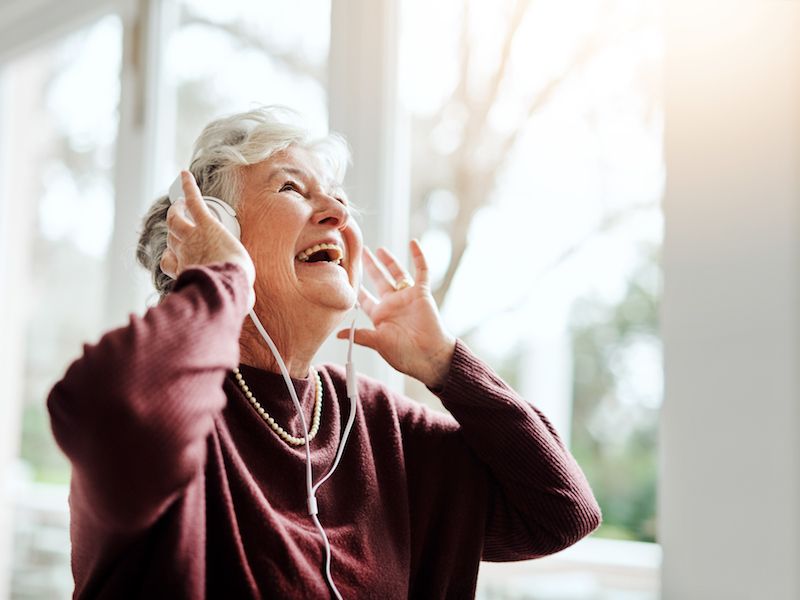
Noise-related loss of hearing doesn’t only impact people who work in loud environments, such as construction workers or heavy metal roadies. Recreation associated noise exposure can be just as harmful as work related noise exposure. The most prevalent type? Loud noise heard through headphones, whether it be music, gaming, streaming video, or even an audiobook with the volume cranked up.
You might not think your smartphone or tablet can go that loud. But these devices can reach continuous volumes of over 105 dB, which is around the normal human threshold for pain. Your ears will literally start to feel pain at this volume. So what’s the answer for protecting your hearing against volume related injury.
The volume level here is significant. Listen with the volume at or below 60% for no more than 60 minutes each session (how long you listen for also makes a difference), this is called the 60/60 rule.
Create a Setting on Your Hearing Aids For Music
Be certain, if you’re using hearing aids, you don’t try to drown out other sounds by cranking your streaming music up too loud. Also, consult us about how best to listen to music. If you’re a musician or someone who loves music you may have noticed that most hearing aids are programmed to improve the clarity of voices…not necessarily music. While listening to music, we can most likely make various adjustments to help improve the sound quality and lessen the feedback.
How to Choose The Best Headphones
If you don’t use hearing aids, there are many choices for shopping for headphones. It might be a matter of personal choice, but there are some things you should consider there too.
Over-the-Ear Headphones
While the foam-covered speakers that was included with your old Walkman are generally a thing of the past, over-the-ear headphones have made a comeback. They have a lot of options in color and style, are commonly endorsed by celebrities, and can be surprisingly pricey. And unlike those little foam pads, these go over the whole ear, blocking outside noises.
Main-stream wisdom is that these are safer than in-ear headphones because the source of the sound is further away from your eardrum. But the fact is they’re frequently able to reach louder sound than the smaller kind, the speakers are much bigger. Noise cancellation can be a helpful thing as long as you’re not missing out on important sounds like an oncoming car. That said, because they cancel out outside noise, you can normally lower the volume of what you’re listening to so it’s not so loud that it will injure your hearing.
Earbuds
The normal earbuds that are included with devices like iPhones are much maligned for their poor sound quality, but because they come along with your phone lots of people still use them. Especially, with newer Apple devices, it’s simply easier to use the earbuds that were provided with the device because it probably doesn’t have a headphone jack.
The drawback, aside from the inferior sound quality, is that basic earbuds can’t block outside noises, so that it’s more likely that you will pump up the volume. It’s commonly assumed that placing earbuds so close to your eardrum is the main concern but it’s actually the volume.
Noise Blocking Earbuds
More comfortable than ordinary earbuds, models with a round rubber tip are the choice of many people because they help stop outside noise. A seal that blocks outside noise from getting in is formed by the rubber tip which conforms to the shape of the ear. But these earbuds can also block out sounds you need to hear and volume is still the number one problem. And if you use hearing aids, clearly these won’t work for you.
You might need to try out more than one pair before you find headphones that are correct for you. Your expectations, acoustically, will differ depending on what kind of use you usually give them. The important thing is to find headphones that make it comfortable for you to listen at a safe sound level.
How to Make Sure Your Hearing is Safeguarded
How can you be sure it’s okay? There’s an app for that…If you use a smartphone, you can download the National Institute for Occupational Safety and Health’s free Sound Level Meter app. You can get different apps, but research has found that the reliability of these other apps is hit-and-miss (in addition, for unknown reasons, Android-based apps have proven less accurate). That prompted NIOSH to create their own app. You can measure external sounds with the app, but it’s also possible to measure the sound coming from your device’s speakers, so you will learn precisely how much volume your ears are getting. It’s a little bit of effort, but taking these kinds of preventative measures can help safeguard your hearing.
